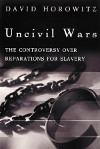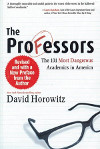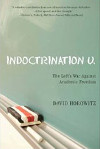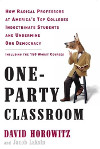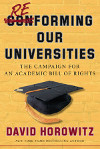Uncivil Wars Introduction
The Fault Line
Some might regard this book as an act of literary masochism.
in the spring of 2001,1 attempted to place an ad in college newspapers opposing the idea of paying reparations for slavery 136 years after the fact. In my view the idea of reparations was self-defeating for the descendants of slaves, and divisive for everyone else. Already a drumbeat of backing for reparations had begun at the level of municipal and even state governments around the nation. The issue seemed an important one to discuss publicly before it attained a critical mass in legislative assemblies. Moreover, it intersected with an ongoing national “dialogue on race” which, since the very origins of this country, has been the most important dialogue Americans can have.
But when my ad appeared on college campuses, the reactions were volcanic and the attacks on me were savage. On campus after campus, protests erupted and indiscriminate rage spilled over into every corner of the public space. It was a breathtaking display of intolerance for an academic community. In their anger, my critics showed little regard for fairness or facts, or common decency. Although I have a long public history as an activist for civil rights, I was attacked in terms normally reserved for bigots of the political fringe. Though my opponents failed to identify a single phrase I had written that denigrated any race or group, my ad was called “hate speech,” “racist” and even “Hitlerian” (this in a lengthy response to my arguments by a professor of Afro-American Studies and the editor of the Black Scholar).[1]
Fortunately, I had my defenders, like Jonathan Yardley of the Washington Post, who described the attacks as “hogwash.” He was joined by John Leo of U.S. News & World Report and by the distinguished black scholar Thomas Sowell, along with the editors of USA Today, the Boston Globe, the Philadelphia Inquirer and other papers, who understood the difference between honest disagreement over ideas and hate. Even the liberal columnist Richard Cohen wrote in the Washington Post, “there’s not a lot in Horowitz’s ad with which I disagree.”[2]
My opponents’ agenda in this controversy was not to refute the ideas the ad contained, but to obliterate the individual who was responsible for them. This had been a classic tactic of twentieth-century totalitarians. In Stalin’s Soviet Union, for example, the charge against all dissidents, whatever their views, was that they were “anti-Soviets” and “enemies of the people.” This isolated them from the world of common decency and created grounds for their “liquidation.” No such drastic measures were imagined here. But there was a clear agenda to identify me—and college editors who printed the ad—with ideas and positions so repellent that any community of right-thinking people would reject us.
In order to describe the events that took place and even attempt to decipher their meaning, I have been forced to chronicle the details of the attack against me. It has not been a pleasant experience. Who would want to endure, let alone remember, such enmity? Yet as the attacks unfolded, many of my critics in the press attempted to minimize their severity by facilely concluding that the entire episode was a political stunt I had dreamed up to win “fame and profit,” as Clarence Page of the Chicago Tribune actually wrote. What was he thinking? Who would want to become famous as a “Nazi racist?”
The controversy put me in an unfamiliar as well as a painful position. I had marched in my first civil rights protest more than fifty years before in behalf of President Truman’s Fair Employment Practices Commission, which outlawed discrimination against blacks in the civil service. I have spent much of my adult life in similar battles for black Americans whose ancestors were brought to this country in chains and whose rights have been denied more than those of any other group. Members of my family are black and I have partly black grandchildren whose future is at stake in these issues.
In the 1970s, my efforts for civil rights led me into a deep involvement with the Black Panther Party, whom progressives, at the time, were calling the “vanguard of the black revolution.” I was attracted to them especially because while other civil rights organizations of the post-King era were all words, and unpleasant words at that, the Panthers appeared to be actually helping people “on the ground” with their breakfast programs for children and health clinics; because they appeared to check the histrionic violence of black nationalist groups; and because they still preached coalitions with whites. But the Panthers turned out to be a vanguard of gangsters, some of whom killed an innocent friend of mine and derailed my life for nearly a decade.[3]
This tragedy could have caused me to become cynical and bitter, but I had invested too much in the idea that individuals should be judged on their merits, not as members of a racial group. I was the one who had been blind, and I could not escape my responsibility by blaming someone else. Under the spell of seductive ideas about “social justice,” I had failed to see the character of the people I became involved with, and had linked others—also blinded — to their destructive cause. After this episode, I decided that my future efforts in behalf of racial justice would be undertaken with open eyes.
My opposition to the reparations agenda, as I will make clear in this narrative, is a product of these sobering experiences and second thoughts. It is not that I eschew “noble causes,” but that I have learned to evaluate them with a skeptic’s eye and to judge them first by their practical consequences. Examining the reparations movement, I came to the conclusion that it was destructive in ways similar to the radical causes I once supported, which have hurt the prospects for ever discovering a promised land that lies “beyond race.”
The pursuit of justice for all individuals is still the goal that shapes my interests as a political writer and social activist, and a continuing source of my self-respect. On more than one occasion during the writing of this book, the malicious comments I was forced to record caused me to flinch. At these times, I asked myself whether I should have taken on the battle in the first place. During the controversy, one of my sons asked another member of the family, “Why would dad want to do this? Why would he want to be called a racist?” Indeed, why would anyone want to put his son in the position where he would have to ask such a question?
This book is an attempt to provide an answer. Although I am the author of its narrative, its subject is not me; nor is it the advertisement that provoked such a reaction. Similar events have taken place before on hundreds and maybe thousands of campuses and similar attacks have been made on hundreds and maybe thousands of individuals—professors, students and campus visitors.
In 1997, to take just one example, a tenured Texas law professor named Lino Graglia, who had taught for thirty-three years without incident, overnight became the target of the same forces I did when he made one remark that the local press quoted in garbled form and out of context. Graglia is a recognized expert on constitutional law and a longstanding public opponent of racial preferences in university admissions, and his legal opinions have been solicited by congressional bodies. When asked by a reporter to explain the low test scores of minority students, he made the commonplace observation that in some minority communities, educational achievement often did not receive support in the home. What followed was a public lynching—of Graglia’s reputation. The NAACP accused him of “racial harassment,” the Hispanic caucus in the Texas state legislature demanded his dismissal, fifty law professors wrote a letter condemning his remarks, and Jesse Jackson told a cheering rally of five thousand students on the University of Texas campus that Graglia should be treated as a “moral and social pariah” for his “racist, fascist, offensive speech.”[4]
The difference between what happened to Lino Graglia and others like him, and what transpired when I placed an ad against reparations in a series of college papers, was that their experiences remained isolated and individual. As a result they could be seen as idiosyncratic, the product of unique circumstances. But the placing of my ad on campuses across the country was like parachuting flares into a nighttime war zone. In an eye blink, their appearance illuminated the dark places of the educational landscape, and the suppression of free speech that is now routine in the academy became national news.
America is a democracy composed of diverse cultures and ethnic communities. Our future, like our past, depends on fidelity to ideas and ideals that inspire a common identity—e pluribus unum. The fault line that threatens this American identity is race. What this means is that there can be no common future if America becomes unable to maintain the affections of its diverse communities or if its political divisions become defined by race.
In the 2000 presidential campaign, candidate Al Gore touched this fault line when he challenged the idea that Supreme Court justices should adhere to the meaning of the constitutional text. He said: “I often think of the strictly constructionist meaning that was applied when the Constitution was written, how some people were considered three-fifths of a human being.” In making these remarks, the vice president had fallen under the spell of a revisionist message that the United States Constitution is racially suspect. It is a false history, but it has been repeated so often and over so many years that it is already ingrained as popular myth, particularly among Americans of African descent. African-American students at Duke University protesting my ad, for example, chanted, “We are not three-fifths of a student.”
In fact the United States Constitution does not mention race, let alone consider Americans who are black to be three-fifths of a human being. The famous three-fifths compromise was made over the census count of slaves. While all slaves were black, at the time the Constitution was written there were also tens of thousands of free blacks who were citizens and whom the census counted as full human beings. The purpose of the count was to determine the assignment of congressional districts, and thus the distribution of governmental power. It was the awti-slavery Founders who proposed the three-fifths compromise in order to diminish the electoral strength of the slaveholding South. It was the party of slavery, on the other side, that wanted to count slaves as full citizens in order to increase their power to protect the slave system. In other words, from the point of view of the slaves themselves, it would have been better (and truer) had they been counted as only one-fifth of a citizen, or—better still—not at all. The slander against the Constitution contained in the myth about the three-fifths rule is even worse in its ramifications than the slander of individuals, because it is an assault on the very foundations of the nation.
This narrative, then, is about a dubious issue—reparations for slavery—and the fierce response that an effort to initiate a dialogue about this issue caused. In a larger sense it is also a book about the intellectual vulgarities of American universities in an age of “political correctness.” It shows that the term “politically correct” is actually far too genteel a description for what is better understood as a totalitarian mind-set. It reveals, in the inner sanctums of our most elite universities, swamps of almost bottomless ignorance and malice. It makes disturbingly clear that the liberal arts divisions of American institutions of higher learning are breeding grounds of some of the most retrograde ideas and reactionary trends in our political culture and, worse, shows that the behaviors are protected and even encouraged by the guardians of the institutions themselves.
Los Angeles, July 4, 2001
[1]Robert Chrisman and Ernest Allen Jr., “Ten Reasons: A Response to David Horowitz,” www.umass.edu/afroam/hor.html.
[2]Jonathan Yardley, “Politically Corrected,” Washington Post, 5 March 2001; Richard Cohen, “Specious Speech,” Washington Post, 22 March 2001.
[3]These events are narrated in my autobiography, Radical Son: A Generational Odyssey (New York, 1997).
[4]Martin P. Golding, Free Speech on Campus (New York, 2000), p. 82. For studies corroborating Graglia’s contention cf. John McWhorter, Losing the Race: Self-Sabotage in Black America (New York, 2000).
